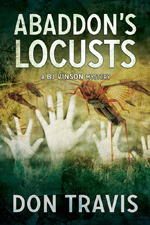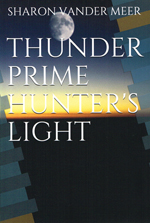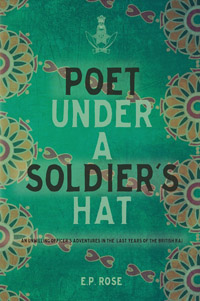Don Morgan, author of 14 published novels, uses three pen names (Donald T. Morgan, Don Travis, and Mark Wildyr) to separate one diverse genre from another. As Don Travis, he’s released five mysteries through Dreamspinner Press, with a sixth scheduled for publication by the end of 2019. Abaddon’s Locusts (January 2019) is his newest book and the fifth volume in the BJ Vinson Mystery series that follows a private investigator and his partner as they solve crimes across New Mexico. You’ll find Don on his website at DonTravis.com and on Facebook and Twitter. Read more about Don and his writing in his 2018 SWW interview.
 What is your elevator pitch for Abaddon’s Locusts?
What is your elevator pitch for Abaddon’s Locusts?
When BJ Vinson, an Albuquerque confidential investigator, learns his young friend, Jazz Penrod, has disappeared and has not been heard from in a month, BJ discovers some ominous emails. Jazz has been corresponding with a “Juan” through a dating site, and that single clue draws BJ and his significant other, Paul Barton, into the brutal but lucrative world of human trafficking.
What would you like people to know about the story itself?
The idea for the story comes from two different directions. I wanted the opportunity to bring back hip, young Jazz Penrod (whom we met in the second book in the series, The Bisti Business) and BJ’s neighbor, septuagenarian Gertrude Wardlow, a retired DEA agent and neighborhood busybody. I also wanted to shed light on the serious problem of sex trafficking, especially on the Navajo—and other—Indian reservations. When Jazz is rescued, it is this white-haired old lady who has the experience to help Jazz kick the drug the traffickers have hooked him on. I had fun with the story yet told about something that should be more widely known.
BJ Vinson and Paul Barton return as the main characters in this newest novel in the series. What is it about these two characters that makes readers connect with them?
They are ordinary people. They live as a gay family unit, but they live their daily lives little different from straight folks. They live, they love, they make great decisions, goof up now and then. Except for who they love, they are little different from you and me in lifestyle. Now to be clear, their skills far exceed mine. I don’t know about the reader, but I couldn’t begin to match them professionally. Of course, it doesn’t hurt that they’re handsome and likeable, as well. BJ’s twelve-million-dollar trust fund from his schoolteacher parents helps things along, as well…but that’s a different story.
What unique challenges did this work pose for you?
I knew nothing about sex trafficking beyond what we all read in an occasional headline. I found several different legal jurisdictions to be helpful, especially Detective Sergeant Amy Dudewicz of the Bernalillo County Sheriff’s SVU department. Surprisingly, I contacted a Navajo organization helping the victims of such traffickers, and they refused to speak to me. I also ran into a writing situation I hadn’t addressed before. All the BJ Vinson books are told in the first person, meaning our protagonist is the “I” in the story. But in Abaddon, I found it necessary to do a few chapters from Jazz’s point of view, which meant Jazz was the “he” in the book. I had never written a manuscript using both the first-person and the third-person viewpoint. But I think it worked.
You’ve said previously that your BJ Vinson Mystery series features “New Mexico as a continuing character. Each book showcases a different part of this beautiful State.” What is the setting for this book, and why did you choose it?
The subject matter for the book more or less dictated its locale. BJ’s trek to find the missing Jazz takes him (and the reader) to the Four Corners area—Farmington and Ship Rock. The trail leads him back to Albuquerque, and then to two smaller Navajo reservations: Tohajiilee, west of Albuquerque, and Alamo, down near Socorro. Born and raised an Okie, I have a torrid romance with the great state of New Mexico.
Tell us how you came up with the evocative title of the book.
You might say the title generated the book. I was looking up something totally unrelated and ran across the biblical reference to Abaddon and his locusts. A friend teaches a bible class locally, and when I learned he was in the Book of Revelation, I attended a couple of his classes that specifically dealt with the plague Abaddon visited upon the earth. He brought up out of the underworld locusts which were not locusts to plague mankind. All but the true believers were bedeviled by his locusts, driving some mad and some to suicide. After five months, the plague vanished. Why five months? Who knows, but that is approximately the lifetime of a typical locust. It seemed a metaphor for the youngsters who are snared in the sex trade trap and then unleased on street corners to beg or offer themselves to generate money for the traffickers.
What was your favorite part of putting this project together?
Finding Jazz a love interest. In The Bisti Business, he offers himself to BJ, who turns him down, saying he was committed to another. That impressed the teenager so much that he stopped having casual affairs and began looking for a permanent life partner, and that is what made him vulnerable to the traffickers. Finding Klah Hatahle and letting them discover one another was great fun. Of course, to me, Mrs. Wardlow is also fun. She may be a busybody, but she’s pulled BJ’s and Paul’s chestnuts out of the fire more than once.
When writing a series, what are the key issues to keep readers coming back for more?
I’m not certain this directly answers your question, but one thing that is often difficult for series writers is making certain that a reader can pick up the fourth or even the sixth book in the series and make total sense of who the major players are and how they connect. All of this without bogging down the book with too many references to prior books. Not easy but essential…unless you are one of those readers who always starts with the first book in the series and proceeds book by book thereafter.
Do you prefer the creating or editing aspect of writing?
Succinctly put, the original draft is a pain, the second draft (first edit) is pure pleasure, and every draft thereafter is necessary torture.
How do you feel about research?
I research all of my books extensively and am rewarded when my publisher starts her editing process. Every time a historical fact or a specific address or a specific known event is mentioned, the publisher’s editing team fact-checks. Only twice have they challenged me. I was right in one instance; they were in the other. And that, by the way, was a historical novel written under a pseudonym.
What typically comes first for you: a character? An era? A story idea?
Sometimes, it’s a title (largely true for Abaddon, for The Zozobra Incident, and The City of Rocks). Sometimes, it’s a story I want to tell because it’s appropriate to the moment (again, Abaddon). For my alter ego (the historical writer) it’s clearly the era. But I must always have a character firmly in mind. I do not outline, but for every book I’ve written except one, I’ve known the ending before I started. That one exception about drove me crazy. It wandered all over the place before shuddering to an end.
What advice do you have for beginning or discouraged writers?
The same advice I give to my writing class. When you sit down to write your novel, your short story, your poem, your essay, or your memoir, write it from beginning to end. If you stop and start editing, it will take you ten times as long to both write the story and edit it. Ours is a slow business (often a year or better before a completed manuscript comes to publication), so don’t slow it down even further by trying to do two jobs at once. And make no mistake, original writing and editing writing are two different chores.
What writing projects are you working on now?
My sixth BJ Vinson Mystery, titled The Voxlightner Scandal, is scheduled for release by Dreamspinner Press on November 19. Last week, I started my seventh, tentatively titled The Cutie-Pie Murders.
 KL Wagoner (writing as Cate Macabe) is the author of This New Mountain: a memoir of AJ Jackson, private investigator, repossessor, and grandmother. Kathy posts to a speculative fiction blog at klwagoner.com and writes about memoir at ThisNewMountain.com.
KL Wagoner (writing as Cate Macabe) is the author of This New Mountain: a memoir of AJ Jackson, private investigator, repossessor, and grandmother. Kathy posts to a speculative fiction blog at klwagoner.com and writes about memoir at ThisNewMountain.com.


















